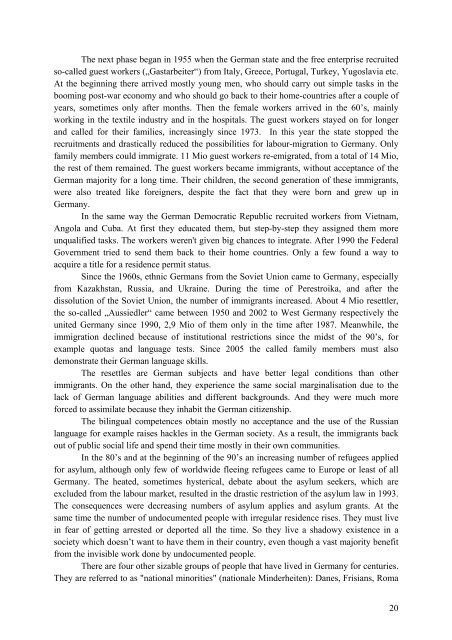Copyright © 2007, Editura ASE - BONUM
Copyright © 2007, Editura ASE - BONUM
Copyright © 2007, Editura ASE - BONUM
Create successful ePaper yourself
Turn your PDF publications into a flip-book with our unique Google optimized e-Paper software.
The next phase began in 1955 when the German state and the free enterprise recruited<br />
so-called guest workers („Gastarbeiter“) from Italy, Greece, Portugal, Turkey, Yugoslavia etc.<br />
At the beginning there arrived mostly young men, who should carry out simple tasks in the<br />
booming post-war economy and who should go back to their home-countries after a couple of<br />
years, sometimes only after months. Then the female workers arrived in the 60’s, mainly<br />
working in the textile industry and in the hospitals. The guest workers stayed on for longer<br />
and called for their families, increasingly since 1973. In this year the state stopped the<br />
recruitments and drastically reduced the possibilities for labour-migration to Germany. Only<br />
family members could immigrate. 11 Mio guest workers re-emigrated, from a total of 14 Mio,<br />
the rest of them remained. The guest workers became immigrants, without acceptance of the<br />
German majority for a long time. Their children, the second generation of these immigrants,<br />
were also treated like foreigners, despite the fact that they were born and grew up in<br />
Germany.<br />
In the same way the German Democratic Republic recruited workers from Vietnam,<br />
Angola and Cuba. At first they educated them, but step-by-step they assigned them more<br />
unqualified tasks. The workers weren't given big chances to integrate. After 1990 the Federal<br />
Government tried to send them back to their home countries. Only a few found a way to<br />
acquire a title for a residence permit status.<br />
Since the 1960s, ethnic Germans from the Soviet Union came to Germany, especially<br />
from Kazakhstan, Russia, and Ukraine. During the time of Perestroika, and after the<br />
dissolution of the Soviet Union, the number of immigrants increased. About 4 Mio resettler,<br />
the so-called „Aussiedler“ came between 1950 and 2002 to West Germany respectively the<br />
united Germany since 1990, 2,9 Mio of them only in the time after 1987. Meanwhile, the<br />
immigration declined because of institutional restrictions since the midst of the 90’s, for<br />
example quotas and language tests. Since 2005 the called family members must also<br />
demonstrate their German language skills.<br />
The resettles are German subjects and have better legal conditions than other<br />
immigrants. On the other hand, they experience the same social marginalisation due to the<br />
lack of German language abilities and different backgrounds. And they were much more<br />
forced to assimilate because they inhabit the German citizenship.<br />
The bilingual competences obtain mostly no acceptance and the use of the Russian<br />
language for example raises hackles in the German society. As a result, the immigrants back<br />
out of public social life and spend their time mostly in their own communities.<br />
In the 80’s and at the beginning of the 90’s an increasing number of refugees applied<br />
for asylum, although only few of worldwide fleeing refugees came to Europe or least of all<br />
Germany. The heated, sometimes hysterical, debate about the asylum seekers, which are<br />
excluded from the labour market, resulted in the drastic restriction of the asylum law in 1993.<br />
The consequences were decreasing numbers of asylum applies and asylum grants. At the<br />
same time the number of undocumented people with irregular residence rises. They must live<br />
in fear of getting arrested or deported all the time. So they live a shadowy existence in a<br />
society which doesn’t want to have them in their country, even though a vast majority benefit<br />
from the invisible work done by undocumented people.<br />
There are four other sizable groups of people that have lived in Germany for centuries.<br />
They are referred to as "national minorities" (nationale Minderheiten): Danes, Frisians, Roma<br />
20


